6.1 Our business challenges
At Madrileña Red de Gas, as a natural gas distribution company essentially limited to the Autonomous Community of Madrid, during the materiality analysis process we have evaluated a set of challenges and key aspects for the business which, due to their impact on stakeholders and the future of the company, are an absolute priority, from both an internal and external perspective.
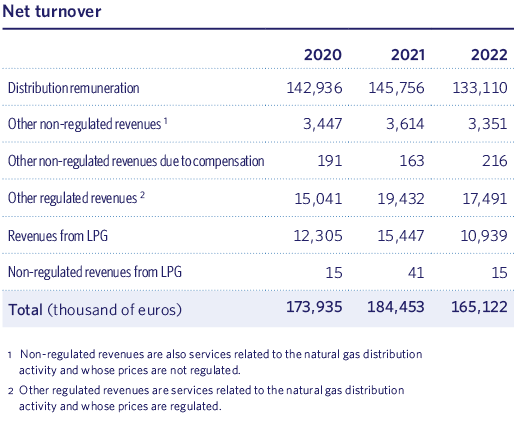
Thus, our sole shareholder requires economic results in the medium and long term, in other words economic sustainability, although the commitment of the partners to sustainable development marks the company’s policies and strategies. We extend the network as we aware that our raison d’être is to distribute energy, without seeking short-term economic results, although always seeking the greatest efficiency and effectiveness of our processes.
Extending the network and working to get new supply points, within the rules of the regulated market, is the strategic line that has allowed us to grow, get to where we are as a company, and think about continuing to develop the business, although this line is currently facing new challenges. The commitments of all governments and societies in the fight against climate change show us the need to be participants in the energy-transition process. At Madrileña Red de Gas we are collaborating with and promoting innovative projects that allow us to talk about the future distribution of renewable gases, such as green hydrogen or biogas, via our own networks. Participating in this transition process and transforming ourselves in it will be key to our existence in the future.
The access to energy that the distribution network has brought to the different districts and municipalities of the Autonomous Community of Madrid has value for society to the extent that its supply is reliable and continuous, as well, of course, as being safe. This is possible thanks to excellent maintenance of our installations and the organization of our 24-hour emergency services. We are currently working in the Network Operation and Maintenance area to prepare ourselves to continue to offer the same guarantee of supply when renewable gases circulate through our networks in the future.
As a service, we believe that irrespective of the fact that our teams work to guarantee supply, it is essential that communications with our customers and end users are agile, with efficient and decisive processes. Customer orientation has always been relevant for us, and we have taken advantage of all the options that new technologies offer in this regard.
6.2 Generating economic value
2022 has been characterized by the conflict between Ukraine and Russia and by high volatility and uncertainty in the markets. In this context, MRG continues to show its ability to maintain stability in the face of adverse economic cycles and unexpected events, obtaining excellent results that confirm its marked financial resilience, as well as solidity and predictability in the generation of revenues.
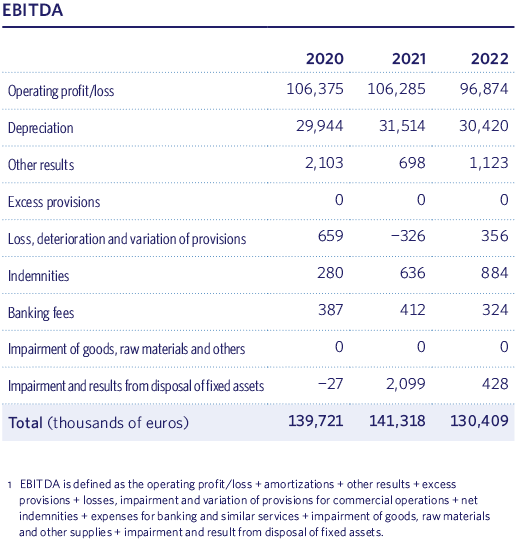
EBITDA in 2022 was 130.4 million euros, 8% less than in 2021, mainly due to lower revenues recorded due to lower gas demand as a result of lower temperatures and regulatory cutbacks. This year has been the second in which the gas year has closed on 30 September, in accordance with the methodology of the current regulatory period (2021–2026).
Looking at our GRI 201.1 indicator Economic value generated and distributed in 2016, our figures for 2022 show a distributed economic value of 80,616 (thousand euros), 1.4% less than in 2021, and a retained economic value of 175,727 (thousand euros), with a clear increase resulting from the high financial revenues of 2022.
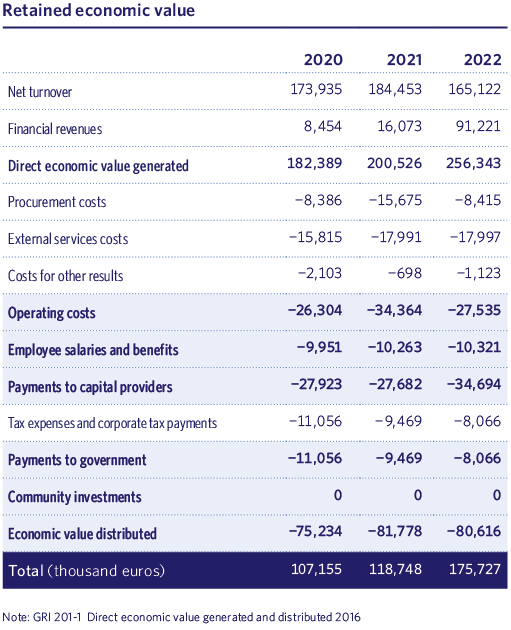
Since 01 July 2015, the Company has been taxed under the Tax Consolidation Regime as a Company dependent on Tax Group No. 474/15, whose parent entity is Elisandra Spain IV, S.L.
6.3 Network expansion: in the present but looking to the future
The company’s growth strategy continues to be focussed on profitable and sustainable expansion in our and adjacent territories. We are fully aware of the need to look towards renewable gases, both as a response in our fight against climate change and in view of the growing social awareness, not only in the face of emissions, but also in view of the need for a stable energy market. In this context, we believe that expansion of the natural gas distribution network looks at both the present and the future, and we can talk about a gas and a network that facilitate access to energy and the energy transition; we are talking about an energy source taxonomically considered to be “green”, in this transition period, and we are talking about a distribution network capable of distributing H2 or biogas in the future.
Currently, the problem that exists in the distribution of renewable gases is not the network itself but the ability to generate these gases. As such, we support projects that in the future may represent that source of renewable gas that we can distribute, while continuing to expand our network of pipeline facilities which, although they distribute natural gas, are 100% prepared for the distribution of biomethane and hydrogen.
The current situation of a global energy crisis, the effects of the war in Europe, as well as the continuous regulatory changes, are having a significant impact on the energy market, and on the gas system in particular. These factors have had an impact on the growth in new supply points, which has been lower than in previous years.
In 2022, Madrileña Red de Gas has achieved a total of 13,299 new natural gas installations commissioned as a result of the commercial actions for organic growth of the Expansion Department.
At the close of 2022, Madrileña Red de Gas distributes gas to 908,984 supply points, of which 900,911 are natural gas and 8073 LPG. This growth, together with that generated by other inorganic growth actions, has allowed Madrileña Red de Gas to exceed the historical figure of 900,000 supply points, positioning itself as the fastest growing natural gas distribution company in Spain and approaching the second position in terms of total volume of installations.
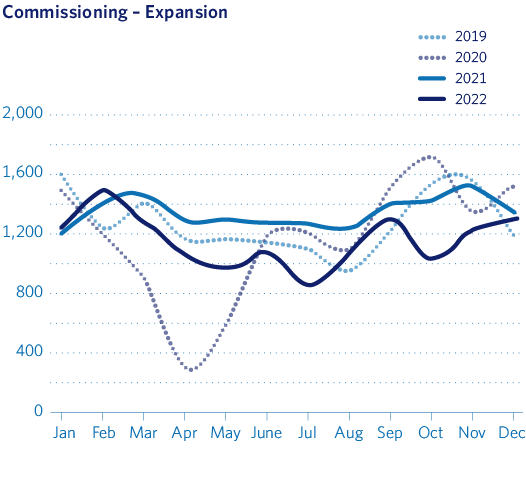
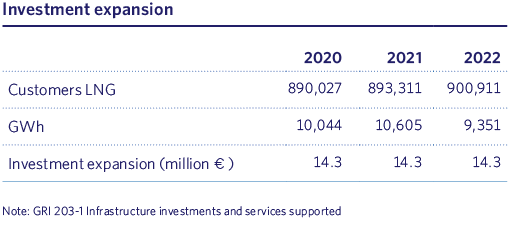
Analysing the more global data of our expansion effort, and comparing from 2020, we can see how in 2022 we have indeed made a great effort, although the final figures for energy supplied have suffered a slight decrease due to the complex situation we have experienced with the energy crisis.
If we analyse the evolution of new supply points segmented by market type, the effect on the new housing market due to regulatory changes associated with the Technical Building Code, which favours electrification and the appearance of new technologies, is observed. At Madrileña Red de Gas we are working to offer developers new hybrid heating solutions and new strategies such as renewable gases.
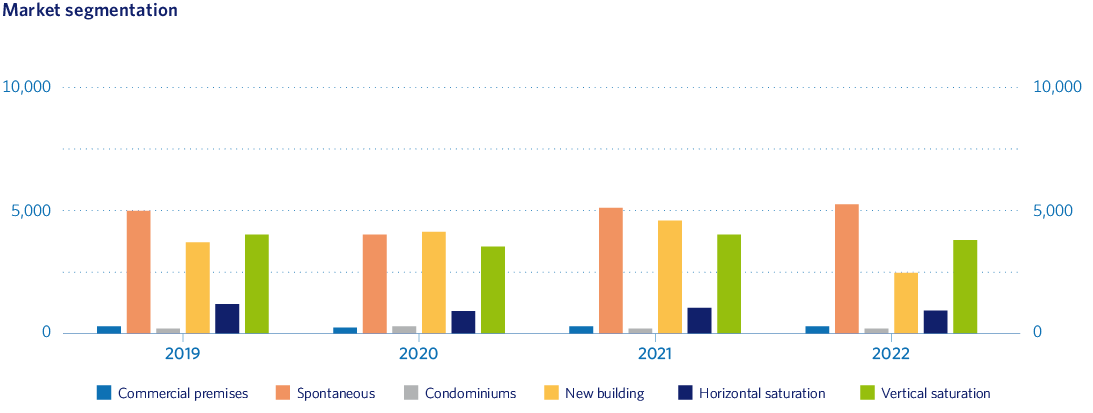
However, no major changes were observed in the rest of the natural gas markets (Horizontal Saturation (HS), Vertical Saturation (VS), Spontaneous (SP) and Commercial premises (CO)), which maintained a trend in line with previous years. It should be taken into account that the geographical area of gas distribution is predominantly residential and that the capillarity of Madrileña Red de Gas’ network is such that there are few areas in which there is no distribution network.
This once again highlights the success of our commercial policy, innovating with new strategies and channels to reach the end user.
In 2022 we have increased our commercial efforts with different types of campaigns to promote vertical and horizontal saturation:
- Specific campaigns throughout the territory: aimed at increasing the HS and VS market, mobilizing up to 6,000 homes through the conventional channel of installation companies and at promoting new pipelines and saturation of the existing ones with an impact on each home, thus generating a specific offer of interest.
- Digital campaign on main social networks: through Facebook and Instagram and aimed at 37 municipalities, in order to capture supply points in the HS market. Controlled and managed directly by the market managers. Examples of the images and messages used can be found below.
- Campaign for individualisation of central systems in owners’ associations (PG): due to the increase in the price of gas, some associations have considered individualising central heating services, especially where non-payment problems occur. At MRG we facilitate this choice, which is much easier to implement, by way of a special campaign.
As regards new builds (NBs), in 2022 a total of 4129 homes have been provided with a natural gas supply. Of these, 2595 homes are equipped with individual boilers and 1534 with central boilers. This year the introduction of other solutions for the energy needs of buildings, such as air source heat pumps and ground source heat pumps, has been clearly highlighted. The entry into force of the modification to the CTE (Technical Building Code) during 2022 has confirmed these changes (this Technical Code continues to allow the use of natural gas, which also obtains the highest rating).
Our Expansion Department has worked intensively with developers, holding meetings with each of them in order to try to find out the energy preferences of their future developments and inform them of the existing options.
The “efficiency” of air source heat pumps depends on the geographical region in which they are installed. At Madrileña Red de Gas, together with the engineering company ESCAN, we have carried out a detailed analysis, which we have shared in our meetings with real estate developers. Among the main conclusions shared, we can see how air source heat pumps cause consumption peaks during start-up, especially on hot or cold days, which can trip the circuit breakers in homes, or even cause power cuts that affect other neighbours.
Moreover, gas boilers are compatible with renewable gases. They even work with 20% hydrogen in commercial units and an increase in this percentage is expected in the next few years.
During 2022, and in collaboration with Empresa Energética and Aedas Homes, the first agreement was signed to install natural gas boilers to support air source heat pumps (180 homes – Majadahonda).
We provide the required guarantee and reliability to the energy mix
Another milestone achieved this year has been the supply of natural gas to the District Heating of Móstoles. District Heating, or district networks, comprises a central power generation facility and a network of pipes, normally buried, through which thermal energy circulates and is distributed through the circulation of steam or hot water.
The District Heating of Móstoles is the largest urban heating and domestic hot water (DHM) network in Spain, comprising 6500 homes. It was inaugurated in 2017 and the plant comprises two 5000 kW biomass boilers and a 2000 kW back-up boiler plus two 5000 kW biomass boilers with an expected consumption of 5934 tons of biomass per year.
After five years of operation, natural gas back-up has been included by installing two 4600 kW boilers and one 1650 kW boiler, since biomass alone did not achieve the expected and necessary performance of the thermal equipment.
At MRG we promote the combination air source heat pump/natural gas, focusing on important aspects such as improved energy efficiency, identical energy rating, lower life cycle cost, reliability, improvement of service guarantee and preparation for the future, thinking about renewable gases, implied by the natural gas network.
If we consider large consumers, natural gas continues to be essential throughout industry. This year, and despite the uncertainty caused by the crisis in Ukraine, as this is a stable and secure supply for industry, we have obtained excellent results, increasing consumption by 180 GWh and 466 new supply points.
In line with our efforts to facilitate access to energy, we would like to highlight the incorporation of three crematoria: El Escorial, Colmenar Viejo and Valdemoro. The former two previously used other energy sources, namely propane gas and diesel, respectively. The companies that operate them decided to install new furnaces with natural gas as fuel, thus improving their efficiency and environmental emissions. The peculiarity that all these crematoria have, due to their activity, is that they are located on the outskirts of the municipalities, therefore MRG made a large investment, as these are complex works and far from the distribution network, to ensure that they have access to energy that is more respectful with the environment.
6.4 Striving for innovation, favouring the future of renewable gases
As we are aware of the importance of promoting and being part of the energy-transition process, we are working together with other companies on innovative studies and projects to favour the incorporation of renewable gases in the future energy mix.
CavendisH2
We are partners with SEDIGAS in the CavendisH2 study, which analyses the competitiveness of renewable gases and their role in the energy transition.
This study includes the feasibility of using the existing gas infrastructure to supply different types of renewable gases, including the blending of up to 20% and 100% hydrogen by volume, as well as the costs of adapting it. if necessary.
After an in-depth analysis of the competitiveness of renewable gases and the investment required to adapt current gas infrastructures, a comparison was made with the High Electrification scenario in order to elucidate the best way to achieve decarbonisation of the economy.
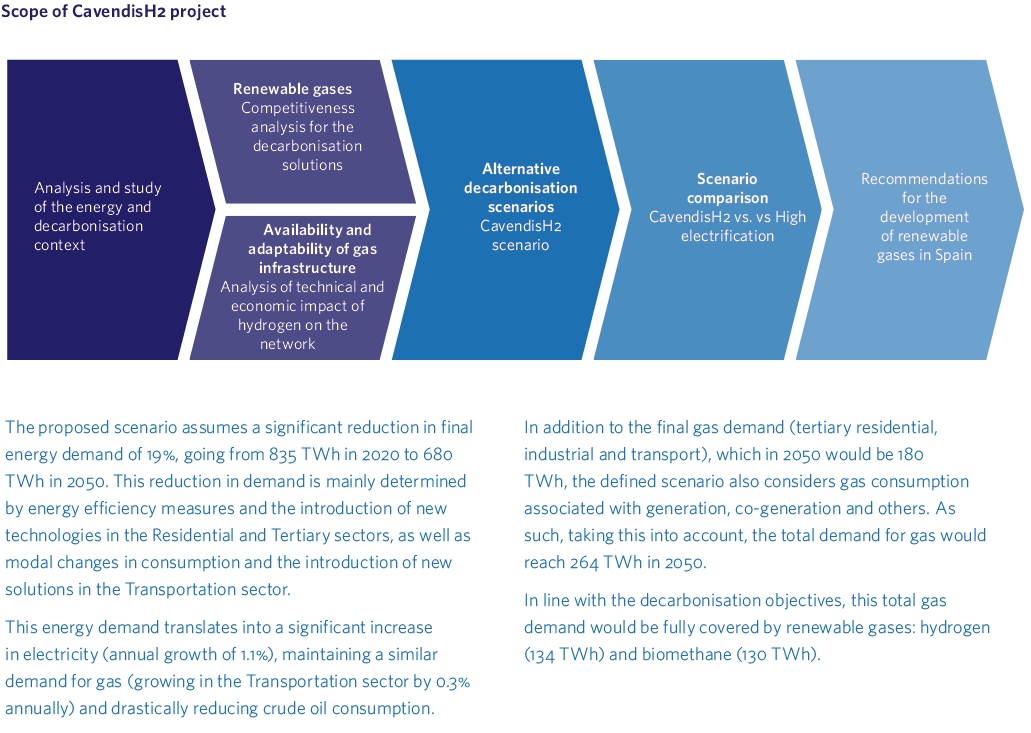
Taking into account the competitiveness of the different decarbonisation solutions and the analysis of adaptation of the gas network to supply hydrogen, an energy scenario for the coexistence of technologies known as “Base Scenario: CavendisH2”, in which both renewable gases and electrification are considered, has been defined.
In cost terms, the CavendisH2 scenario proposes an alternative that would mean a marginal annual investment 30% lower than the High Electrification scenario, mainly due to a lower cost of reinforcing the electrical network and a lower cost of adapting the equipment of residential users.
In addition to a lower investment effort, the greater penetration of renewable gases in the CavendisH2 scenario would complement the development of renewable energies for electricity generation, which would mean a more reliable, flexible and secure system, would reduce potential barriers to entry, requiring less investment in terms of subsidies, and would promote the development of Spain’s role as a generator and exporter of hydrogen.
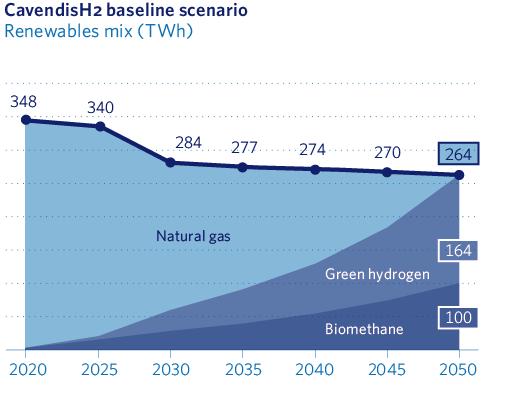
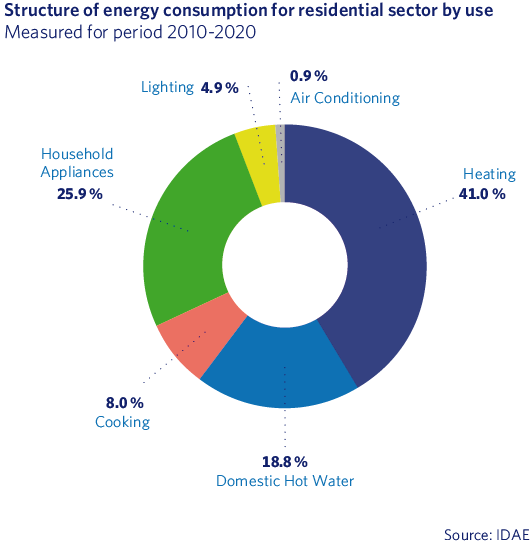
H2 as an alternative for domestic consumption
Between 2010 and 2020, heating and domestic hot water (DHM) accounted for 60.3% of energy consumption in the residential sector. The energy sources to meet this demand are mainly natural gas and electricity.
MRG is committed to the use of renewable gases as an energy vector for heating our homes.
Among the choice of decarbonised gases, hydrogen does not generate greenhouse gas emissions at the point of use, and it only generates water vapour when burnt. It is positioned as one of the clear alternatives to contribute to decarbonisation of the domestic and tertiary sector as a result of its ability to provide a flexible, adapted and continuous energy supply, although it is necessary to promote projects that advance in its real-world application in contrast to the current environment, which is mainly demonstrative.
This need to find alternatives to natural gas is something that is not only taking place in Spain as similar projects are being implemented in other European countries.
Although hydrogen poses many challenges, both technical and regulatory, MRG is clear in its commitment to this gas.
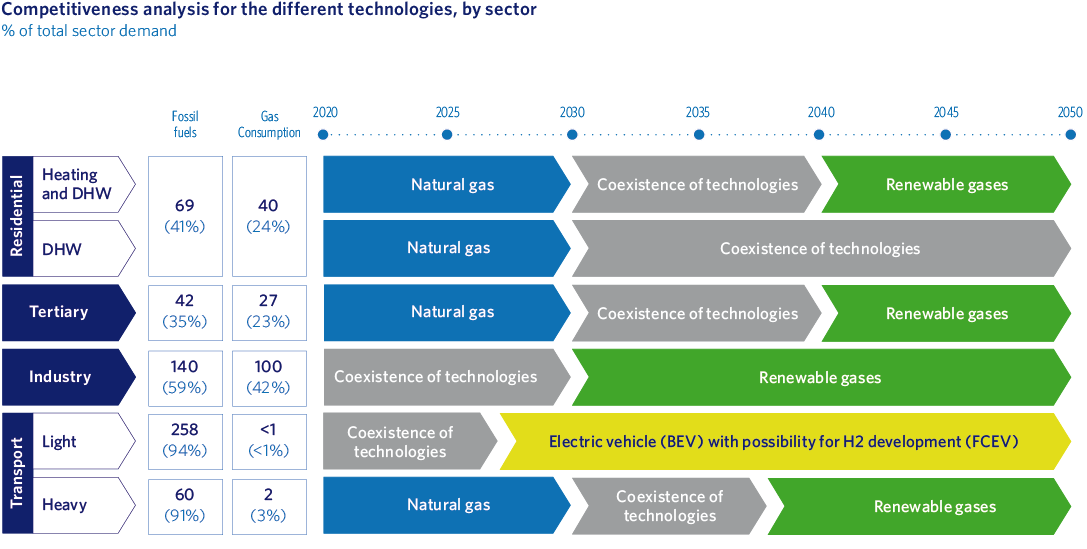
- Pipelines: More than 97% of the gas transportation and distribution pipeline network is prepared for a 100% hydrogen scenario, thus meaning that the remaining 3% must be inspected and replaced, and the capacity level of some distribution areas reinforced.
- Pumping stations: It is necessary to replace the turbine and the compressor, among other measures, as well as increase their power to transport hydrogen, and they may need to be relocated depending on hydrogen flows.
- Regulation and Metering Stations: There do not seem to be any problems with compatibility of materials or operation, although it will be necessary to reinforce or expand the capacity of those RMSs that reach high saturation levels when transporting hydrogen.
- Meters: It will be necessary to progressively replace them with electronic meters prepared for hydrogen, in order to avoid potential metrological errors in membrane meters and possible capacity problems in other types of meters.
Agreement with Pryconsa: use of H2 for heating and Domestic Hot Water (DHW)
Together with Pryconsa, one of the main housing developers in Spain, an agreement was signed in 2022 to provide hydrogen to a newly built building and use it to meet heating and domestic hot water needs.
This project for the use of renewable H2 will meet the heating and DHW needs of a development of 98 homes, located in Valdemoro, the construction of which will begin in 2023.
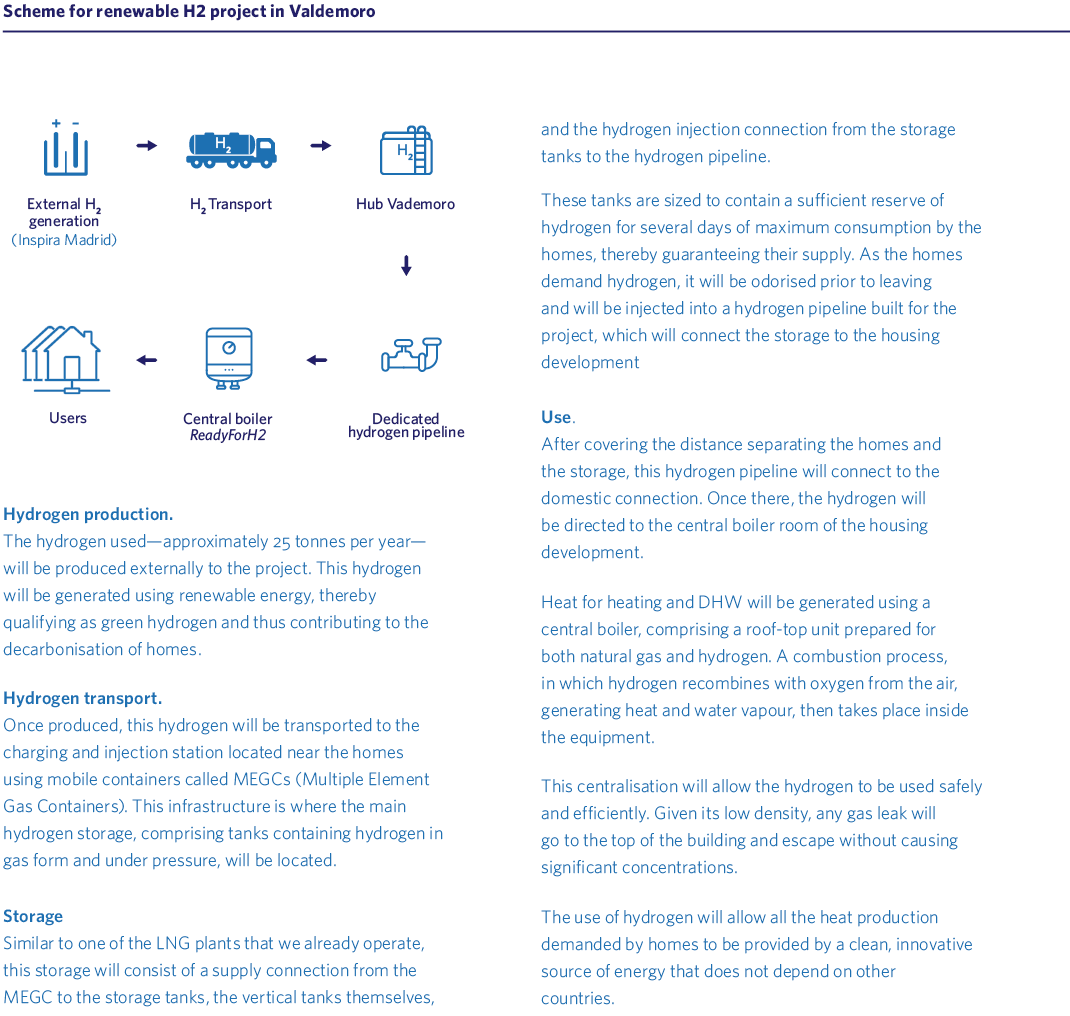
Inspira Madrid Project
As we already mentioned in our 2021 report, Madrileña Red de Gas, together with FRV, the Ruiz Group, and the collaboration of the Madrid Taxi Professional Federation, is participating in currently the most important mobility project with green hydrogen in the Community of Madrid. The initial objective of the project is to participate in the hydrogen value chain, seeking to decarbonise Madrid’s urban public mobility fleets; it is a unique project in this Community.
During development of the project, new alternatives have been explored and the green hydrogen that will be produced as part of the project will be dedicated to both mobility and industrial use.
The project will be undertaken using a modular, flexible and adaptable approach that allows its scalability in successive phases of expansion.
- Phase 1. Installation of a 5 MW proton exchange membrane (PEM) electrolyser for the production of green hydrogen and deployment of five publicly accessible hydrogen stations.
In this phase, the main consumer will be the Community of Madrid’s taxi fleet, with the transformation of an estimated 650 vehicles. The Ruiz Group expects to transform five buses into fuel-cell powered vehicles. - Phase 2. Scale-up of the hydrogen-generation infrastructure. The design allows the capacity of the electrolyser to be scaled-up to 10 MW. As regards supply, extension of the network to 8–10 hydrogen stations, and an increase in supply capacity (from 300 to 600 kg dispensed), is expected. The transformation of 1000 taxis and 20 buses is expected.

During 2022, Inspira Madrid has applied for two of the main aid programs covered by EU Next Generation funds. The MOVES II Program on Incentives for Efficient and Sustainable Mobility and the H2 PIONEROS program which, together with the renewable hydrogen industrial value-chain programs, have been the first lines of aid for the promotion of renewable hydrogen approved by the Ministry for the Ecological Transition and the Demographic Challenge (MITECO) as part of the Strategic Project for the Recovery and Economic Transformation of Renewable Energies, Renewable Hydrogen and Storage (PERTE ERHA).
In addition, the consortium is working on presenting the project for aid from the European Union corresponding to the CEF Transport (Connecting Europe Facility) program, which is aimed at financing infrastructures that promote the development of the Trans-European Transport Network.
BIOMETHANE
Finally, although it is a line of work that we have included in the Environmental Impact chapter of this report, specifically to contribute our efforts within the framework of the circular economy, in this section we would like to highlight the presence of Madrileña Red de Gas in four biomethane projects in the Community of Madrid.
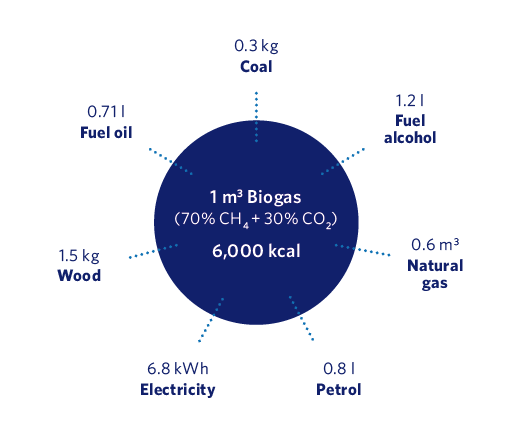
6.5 Supply reliability and guarantee
Madrileña Red de Gas must ensure the security and guarantee of supply at all points of the distribution network and satellite plants. This is a regulated activity with legal obligations regarding quality of service, which MRG complies with by setting objectives that go beyond these obligations.
Operation of the systems involves planning, gas balance monitoring, gas quality control, operation of the network and the facilities from the control centre using SCADA technology, management of the incidents and emergencies that may arise and the necessary maintenance activities.
As discussed in the risk chapter, for emergency management we have clear procedures for action and coordination, as well as the training obtained during drills.
For emergencies we have the Emergency Control Centre (CCAU), which has the human and material resources required to receive all emergency notifications and communicate them quickly, clearly and reliably to the emergency response teams, 24 hours a day, seven days a week. Notification of an emergency to the command line of the technical services affected will always be carried out as indicated in the Emergency Plan.
The CCAU has a telephone system for emergency care, whose calls are saved for two months.
The emergency response teams have the technical and operational knowledge to ensure their correct performance in terms of both the actions to be carried out in transport and distribution networks, as well as in reception facilities, and occupational risk prevention specifications related to such actions.
The priority of a notification will be given based on the level of risk that, a priori, can be deduced from the information collected upon receipt of said notification. There are five levels: 1, 2, 3, 4 and 5 ranging from immediate action to scheduled action, depending on the level of risk or urgency established.
- Priority 1 notifications are those directly related to safety, that is, those in which an accident is reported or it can be deduced that there may be an immediate risk situation, or the call is made by one of the local public services, in all of which our supply is presumably involved. The action will be immediate and at least half of notifications must be attended in a period of less than 30 minutes under normal conditions, and none of them must exceed 60 minutes, except in special justified cases.
- Priority 2 notifications are those reporting a situation which based on the information collected, does not present an immediate risk, problems related to our supply in a certain limited geographical area, or which affect the supply of industrial or commercial customers considered to be important due to their nature. Action will be immediate and they must be attended in a period of less than 1 hour under normal conditions, and none of them must exceed 2 hours, except in special justified cases. These notifications will be attended in a similar manner to those with Priority 1, although the latter will be prioritised should they coincide.
The CCAU may provide support to the intervention team by managing mapping of the network and providing any logistical support that may be necessary.
In Priority 1 and 2 notifications, the emergency care team will never leave the scene of the incident until the facility has been secured or the situation that generated the notification has been resolved and, furthermore, until information concerning the actions carried has been submitted or authorisation is received from the CCAU.
The results are subsequently analysed and an emergency report is produced. This analysis allows response and operation times to be determined and helps to detect opportunities for improvement. In addition to these reports, interim reports, which analyse the weekly and monthly emergency care activity, calculating the ratios that make it possible to evaluate the quality of the service, are also produced.
The reliability of the installations, and therefore of the service, is achieved thanks to the maintenance activities carried out in the distribution network and satellite plants. We have a maintenance management system based on our Technical Standard NT-200.
NT-200 Part 04 establishes the technical criteria and procedures for the maintenance of distribution networks, connections and auxiliary installations. Said document establishes the criteria for carrying out the preventive maintenance plan and corrective maintenance management. There is also a catalogue of incidents, causes and resolutions, which facilitate the generation of corrective orders.
Similarly, NT-200 part 5 and part 6 establish the criteria for the maintenance of satellite LPG and LNG plants and all auxiliary equipment.
The Technical Standard establishes the preventive actions to be carried out for each network pipe and the different assets and equipment that are part of it, and their frequency, depending on their category, with said category being determined by various factors, such as vulnerability, nominal flow, composition of the installation, number of customers affected, existence or not of remote information, industrial supply or not and its characteristics, the number of corrective actions that have taken place in a year, etc.
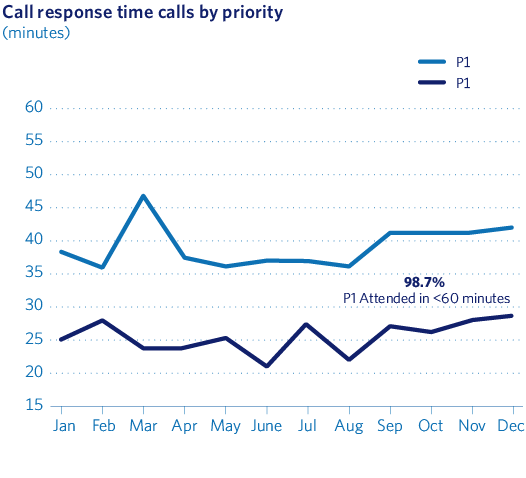
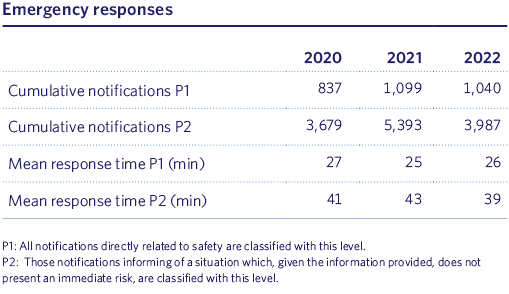
In 2022, Madrileña Red de Gas’ Emergency Department responded to a total of 10,253 emergency notifications.
The response time for the most urgent notifications was 26 minutes for those with Priority 1 (out of a total of 1040 notifications) and 39 minutes for those with Priority 2 (out of 3987).
The most relevant type of notifications were 116 notifications of breaks in our pipeline caused by third parties, which were attended in an average of 29 minutes.
Maintenance Plan
During 2022 we have carried out 100% of the Maintenance Plan established by current regulations, and internal Madrileña Red de Gas regulations, on the 6054 km of network, the auxiliary installations, the 5 satellite LNG plants and 128 existing LPG plants, carrying out more than 14,000 scheduled actions in that regard.
We have managed the correct functioning of the regulation systems at the different pressures, carrying out the corresponding regulatory surveillance on the gas network, the air-tightness control of 2548 km of the gas network, operating more than 7000 valves to verify their correct operation, carrying out nearly 1000 painting/cleaning actions for network elements and 6990 measurements on the equipment that ensures Cathodic Protection of the steel pipes.
As part of MRG’s action plans for 2022, the renovations, meshes and corrective actions required to maintain safe conditions in the network and to guarantee supply in the natural gas and LPG networks have been carried out, substituting materials such as steel, cast iron and/or copper for polyethylene pipe. During 2022 we have also renovated close to 800 metres of copper and steel in LPG networks.
In collaboration with different companies, public bodies and customers, the requests received to setback the gas network due to effects on new urban developments, roads in the Madrid community, construction of new buildings, etc. have been addressed, carrying out approximately 200 meters of setbacks in the gas network.
Thus, monitoring of the route, monitoring of works for preventive maintenance of networks and connections, and inspection visits, exhaustive visits and integral maintenance for Regulation and Measuring Stations, Metering Stations, valves, etc. are established, describing the control points or checklists and the result-based actions for each intervention.
The procedures also include the cleaning, herbicide and rodenticide action plans.
Finally, it is important to highlight that we are fully aware of the changes associated with the energy transition. Our human team must be able to serve the future distribution network, with renewable gases (H2 and BIOGAS). To that end, we have implemented a training project, with a training plan for Operation and Maintenance personnel and a first project to convert a natural gas network to a hydrogen gas network. Our current lines of work are as follows:
- General training in H2 awareness, offered by different external training agents
- Internal dissemination of the progressive knowledge that is being acquired in this area:
- Results of the capacity analysis for MRG networks in the case of 100% hydrogen gas use.
- Specific publications from the hydrogen think-tank Sedigas.
- Sharing of the results obtained in the different analyses and experiences in the UK regarding the use of hydrogen gas in gas-distribution networks.
- Market search for hydrogen gas detection equipment applicable to the gas-distribution activity.
- Participation in the feasibility studies for the different projects and requests related to H2.
- Implementation of the project to convert natural gas networks to hydrogen gas in the municipality of Villanueva del Pardillo in Madrid, carried out by a team of ten Network Operations technicians, which describes the necessary adjustments in the distribution network, their sequences, and the costs to achieve conversion to H2. This first phase corresponds to analysis of the network, and the needs in terms of customer installations and consumer devices will be addressed in a second phase.
6.6 Orientation to customer
In accordance with the regulated business model in which we work, our downstream value chain comprises two categories of customers, the marketing companies that maintain the contractual relationship with the end users, and for which they need our distribution network and associated services (registrations, terminations, metering, billing, etc. and require that our attention at the supply points be as expected by users), and the end users fro whom we provide connection services, access, periodic inspection and emergency care in the event of any problem, via their contract with the marketers. We are also a marketer for LPG users.
Our key goal is service and we have always worked to achieve high levels of satisfaction. At Madrileña Red de Gas we have taken advantage of the possibilities that digitalisation offers to adapt to the needs of customers for many years. Indeed, we have worked to create digital communication spaces: virtual offices, channels via WhatsApp, amongst others, that facilitate the relationship and communication with increasingly demanding end users efficiently and while minimising the time required for their questions to be addressed; or in the development of communication platforms with marketers that support the messaging processes required by current regulations. The pandemic in 2020 accelerated this digital-transformation process.
As we have already commented throughout the report, 2022 was marked by the rise in gas prices to record levels in August 2022 and the enormous uncertainties in the energy market, all of which has affected customers’ needs: many end users have changed contracts with vendors to benefit from the last resort rate in the regulated market, there has been a notable growth in the need for users to be billed based on actual readings and not estimates, and the need to review meters to ensure the quality of their measurement has also increased markedly. All this has led us to improve our processes and channels to maintain the demanding levels of service that we expect.
In 2022, we have again carried out a Customer Experience study to analyse in depth the expectations and perception of vendors, their currently unmet needs, satisfaction rates (CSI), the level of recommendation (NPS) as well as the Customer Effort Score (CES) to measure the perception of how easy or difficult it has been to interact with MRG, identifying the needs for improvement to implement the necessary actions. We were supported by an external company when performing this study. To that end, between the months of June and July, 67 interviews were carried out with 20 contacts from nine marketers, asking about eight types of MRG services or processes.
To continue to make progress in our communication with marketers, we have established the implementation of IOGAS, which was launched at the end of 2021. This is a messaging exchange platform that adheres to CNMC guidelines, in terms of formats and validations, but applying new technologies that enhance the customer experience: operation control, real-time validation and ease of integration and access.
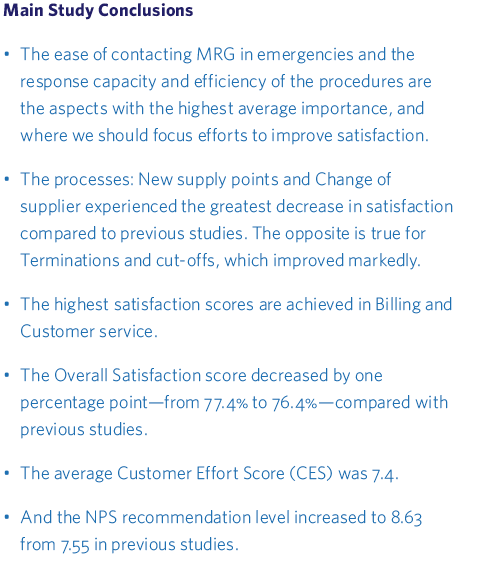
In addition to the specific study mentioned above, actions in the service of Madrileña Red de Gas’ end users are accompanied by a survey that allows us to measure their satisfaction: everything we do is evaluated. Indeed, we have received more than 21,600 responses in 2022 as part of the Periodic Inspection alone. We can clearly see that, despite being a difficult year, we have managed to maintain the customer satisfaction index (CSAT) at 7.6 (out of 10) and Google My Business at 4.0 (out of 5) considering the last two quarters. https://madrilena.es/compromiso/ .
Moreover, a study of the evolution of the results of the customer surveys carried out after the service show a clear improvement.
So, what have we done in 2022 to achieve this?
- We have provided our customers with tips for saving gas without needing make large investments, making a decalogue of 10 ideas available to them, along with a video tutorial, informing them via customer communications and the web. https://youtu.be/zBTB_l73gxs
- A total of 65,000 customers for whom we had no real meter reading for more than 1 year have provided one to us thanks to our information campaigns to comply with regulations and to be able to bill for real consumption, thus avoiding estimates.
- We have processed more than 175,000 vendor changes (+218%), compared to 80,000 in 2021, mainly to vendors regulated with Last Resort Rates, while maintaining deadlines and quality of service.
- We have also performed more than 57,000 field visits.
- We have optimized our WhatsApp customer service channel, offering a premium channel in customer service and experience.
- We have carried out more than 57,000 meter revisions, changing them 11% of the time, mainly due to faults.
Looking at our efforts on customer communication platforms.
WhatsApp has slowly gained ground as the channel of excellence. In the last quarter of 2022 we have implemented a new version and have managed to automate 57% of conversations. However, meter reading is the star process as this can now be done by providing a photograph of the meter, using artificial intelligence with natural language and an OCR to process these photographs.
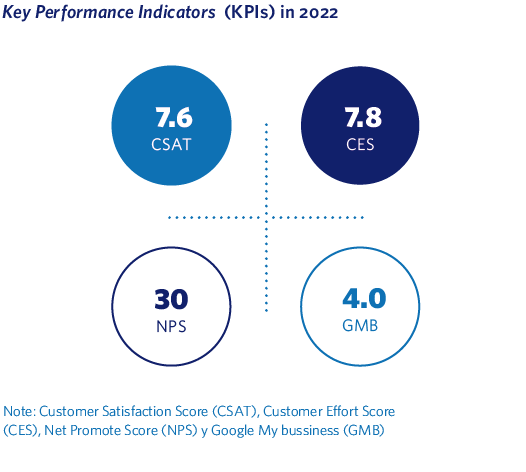
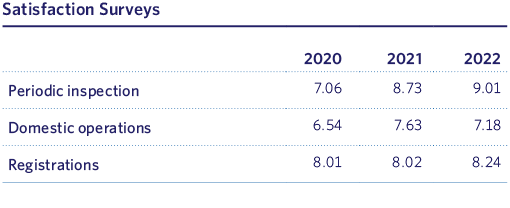
Contextualisation of Call Centre calls
Our customer database allows us to identify customers by the calls they make to the Call Centre. A process has been implemented in which, after identifying the customer, the current situation of their supply point is determined, contextualizing said situation in the CRM that supports the Call Centre via the screen, thus helping the agent to guide management of the possible request that the customer wishes to process and preventing any urgent matter that must be dealt with or extra information that the customer must have. A total of 45 possible scenarios have been parameterised in this process, prioritising, in this first phase, scenarios related to the process of Readings, Periodic Inspection, Commissioning and Domestic operations related to supply interruption, which are the levels of identification of some context found in 64% of calls.
Implementation of engagement to manage requests
To enhance customer resolution in their first contact (First Call Resolution) via any channel, an engagement system with more than 70 types of messages has been implemented in the email, SMS and WhatsApp channels. These messages correspond to eight processes, mainly concerning requests that come to us from the marketers. The objective is to maintain the customer always informed, providing value, both from their own processes, such as readings or periodic inspection, as well as from the requests that MRG receives from marketers. These communications include informative messages of great value to the customer, such as a personalized report of their consumption, and even the possibility of modifying an appointment, seeing the technician’s photo or seeing their route until they arrive at the customer’s home.
We promote customer autonomy when they want to provide a meter reading
With the aim of enhancing customer autonomy as regards providing a meter reading to MRG, in addition to optimizing digital channels such as the Virtual Office or WhatsApp, we have reinforced help and guidance via the call channel centre, explaining to customers who contact MRG via this channel how they can provide readings in the future, via our digital channels (information about platforms, specific sections, information required, etc.), thus achieving both a reduction in readings registered via the call centre and increasing those registered via other channels.
As regards our actions at supply points:
Periodic inspection was our most appreciated process by customers in 2022, thus building on the achievements of 2021. We have worked on the following challenges to achieve this:
- We have worked to consolidate our schedules by offering the necessary availability to allow customers to change appointments, without affecting our success in complying with the periodic inspections that we had to carry out in 2022.
- We have taken into account the information provided by our customers via the different channels, especially including complaints and claims or comments from the surveys carried out at the end of each action. An important example in this regard is that the number of Anomaly Correction Justifications received before issuing the cut-off notice has increased, reaching 83%.
- This year we have closed all complaints within the established timeframe, managing to close 98% within one day.
In 2022 we have also carried out a large number of proactive works in domestic operations, especially:
- 2022 stands out given the large volume of operations in the field derived from the proactivity of Madrileña Red de Gas and the concern of customers due to the increase in their bills requesting a meter review. A total of 57,659 field visits have been made, with an effectiveness of 76%, which resulted in the meter being changed for 11% of the customers visited, mainly due to a fault.
- Customers have become more self-sufficient from their profile in the Virtual Office, and have changed almost 22% of appointments in schedule on their own, whereas this figure barely exceeded 10% in previous years.
- We should also highlight that in IRC Maintenance of the 745 repair jobs carried out in 2022, in none of the cases has it taken more than 72 hours to restore the supply, with the average being 24 hours.
Finally, it is important to highlight the efforts made to comply with the urgent measures in the sector, within the framework of the National Response Plan to the economic and social consequences of the war in Ukraine.
These initiatives require changes in the processes and IT development as a result of the regulatory changes generated. Madrileña Red de Gas has adapted its systems in a short time period to correctly implement the measures:
- Greater flexibility in contracts RDL 6/2022, RDL11/2022, RDL18/2022 and the latest publication RDL 20/2022.
- A new rate of last resort for natural gas temporarily applicable to communities of homeowners (RDL18/2022).
- Improvement in the information available to natural gas consumers as regards energy consumption and choice of supplier (RDL18/2022).
6.6.1 Complaints and claims management
A fundamental way to improve our services is how we handle claims, complaints and reports of irregularities. At Madrileña Red de Gas we have defined a process that we have included in our general procedure PGSG-130, which we reviewed in 2021 to adapt it to the options provided by new technologies.
Our Centre of Excellence is the unit responsible for the process, although if they are unable to be solved directly, they are referred to the Expansion or Network Operation unit, as appropriate, for resolution. When possible effects on the environment rather than service demands are involved, the Centre of Excellence refers them to the units responsible for their resolution depending on the type, in accordance with our procedure PGSG-070 Communication.
The channels for receiving complaints are diverse and include our telephone service, the generic mailbox of the marketers, our generic mailbox atecli, the virtual office via the website, our App (WhatsApp and text messages) and letters (both official and customer), all of which are registered in SAP. Historically, the channel most used by customers is usually the telephone via the Call Centre, where the customer is attended via different IVR options, for which most requests can receive an immediate solution thanks to the automation of responses using decision trees.
In our virtual office, we have markedly improved the attention to requests by introducing bots (artificial intelligence software). These bots allow browsing through the claims section of the MRG virtual office, via solutions, depending on the specific request. This means that the vast majority of complaints made via this channel can be closed in one day. Chatbots have been created to make the experience more pleasant for customers and their interaction with customer service faster and easier.
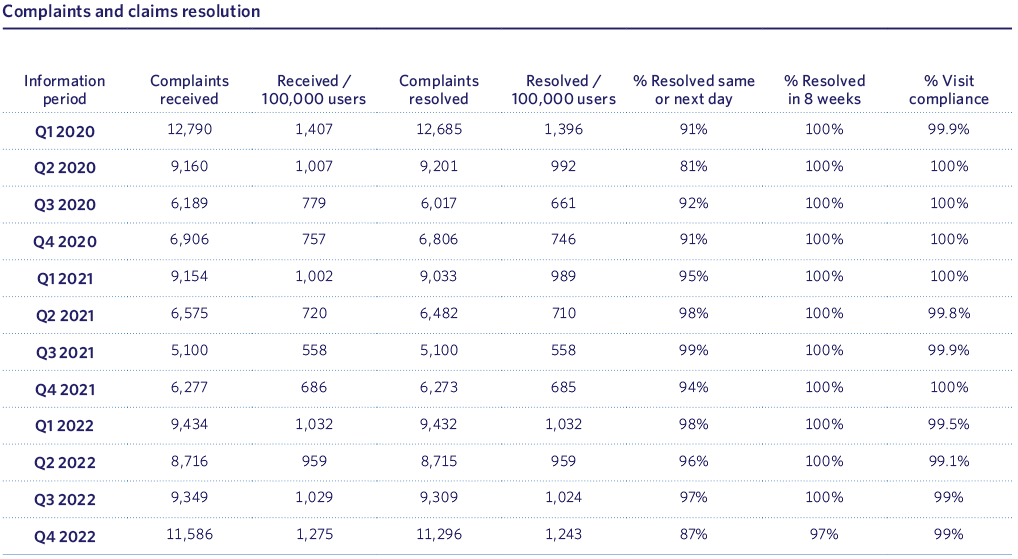
Another of the initiatives implemented are “Customer Trips” for the handling of those claims that may present a greater difficulty, the use of which is intended to achieve greater customer satisfaction by establishing a “fluid conversation” with them and a personalised follow-up throughout the process until its resolution. customers are kept up to date with the interventions carried out and the status of their claims, as well as the information related to them, in real time, via the virtual office.
The Centre of Excellence performs checks on the complaints daily. On a weekly basis, it prepares a report and reporting with all the information that the units may need to properly manage the claims that they must resolve The monitoring KPIs are obtained monthly and quarterly. And the it identifies a need, it prepares and submits ad hoc reports for relevant cases.
Once complaints have been resolved, Madrileña Red de Gas conducts a satisfaction questionnaire to evaluate the resolution mechanisms and measures. The degree of satisfaction with the service provided is determined annually as a means of continuous improvement.
In our space https://madrilena.es/compromiso/ we present our complaint indicators and our commitment actions to resolve the reasons for frequent complaints.
6.7 Efficiency and efficacy in our processes and services as a result of digitalisation
At Madrileña Red de Gas we have been working for many years to move forwards with the digitalisation of our processes.
As part of the DARwin Project launched in 2019, we have been working towards evolving our culture and our systems and processes to a complete digital transformation that places our customers and stakeholders at the centre of our strategy. We have been progressing year after year, mainly in the digitalization of the portability processes for our field work, as well as in the tools that facilitate communication with our customers, and in the management of processes that support the service, improving response times and providing more effective solutions. The virtual office and the IOGAS platform are just two examples in this regard, and these are discussed in greater depth in the customer orientation section of this chapter.
The different organizational units have sought solutions to digitize the processes, working fundamentally on improving efficiency, with the required support from the Customer Systems and Operations department and after approval at the security level.
Virtual office for installers
Since 2022, the Expansion Department has focused on expanding virtual office services for the installer area, investing heavily in improving the personalized section on the web for installation companies. A digital space has been created for the creation of files related to new or never-connected gas connections, in residential housing installations of up to 50 kW, via our Virtual Office, thus allowing their status to be checked and requests to be managed 24 hours a day.
Since the implementation of 100% electronic submission in April 2022, a total of 636 files have been received throughout the year, with an average processing time of 2.52 calendar days.
Similarly, this digital progress also included the requests for gas cuts required to install a new outlet in a shared installation. A total of 152 requests were managed in 2022. The average processing time for these files was 3.94 days.
This progress has also allowed interdepartmental communications to be streamlined, eliminating emails for these procedures almost completely and allowing a file to be immediately associated with specific supply points. Consequently, monitoring and control of the process can be carried out in detail, at any time, and any person involved can access the information in any of its states.
Looking to the future, we hope to achieve that all procedures an installation company needs to do with MRG are unified through the web.
Additionally, expansion of the Enerty tool has continued during 2022, with more than 8000 IRG3 installation certificates for MRG’s distribution area being processed. We have also incorporated the Anomaly Correction Justifications during Periodic Inspections to the certification flow.
With these two projects, Madrileña Red de Gas continues to build loyalty with our commercial channel and collaborating companies, investing in the development of tools that facilitate their tasks and the day-to-day that has an impact on attracting new customers.
Management of potential market and third-party networks
In collaboration with the engineering company REINS and in continuation of the potential management project started in 2021 for the visualization of the entire territory managed by MRG, segmented by market and supply. The third-party networks management viewer has been developed in 2022.
Based on Google Maps technology and through the superimposition of land-registry and cartography layers of our network, we have managed to develop a geo-positioned view of future urban developments where, after signing a collaboration agreement with the developers, future networks prepared for renewable gases will be built, thereby also giving access to future renewable hydrogen networks.
Using control tabs and colour details, we can visualize all those future developments for which we have issued the corresponding feasibility reports for future networks. The information legend gives us a coloured view of the situation of the different urban developments in our territory.
Improvements to our purchasing process and gateway
In line with the digitalisation process, the Purchasing unit uses the SAP tool and the AVANTI portal to communicate with and to manage processes with suppliers. This portal allows us to incorporate different functionalities in a progressive manner. In 2021 we added an invoicing module, the implementation of which has been consolidated in 2022. We have managed to do away with paper invoicing, thus resulting in paper savings and improving the process. Our suppliers send certifications via an approval workflow and enter SAP directly, thereby reducing time and inefficiencies. In 2022, we have also incorporated a work project certification process that allows both Expansion and Maintenance to manage work certifications via the platform, thereby facilitating full traceability of the works from start to finish and achieving very good communication between MRG and contractor companies in a 100% digital manner.
During 2022, we have worked to digitalise the control of commercial contracts, establishing alerts relating to validity, contract review if necessary, guarantees, etc. For this module we have also defined the flow that facilitates the creation of future contracts in a secure manner, thereby channelling the control phases.
In 2023 we intend to continue with digitalisation of the tender process, the supplier payment process and the management of stock orders (to warehouse).
It is important for us to always keep in mind the necessary training of our employees in order to successfully address the digitalisation process and the unavoidable learning curve during its implementation.

